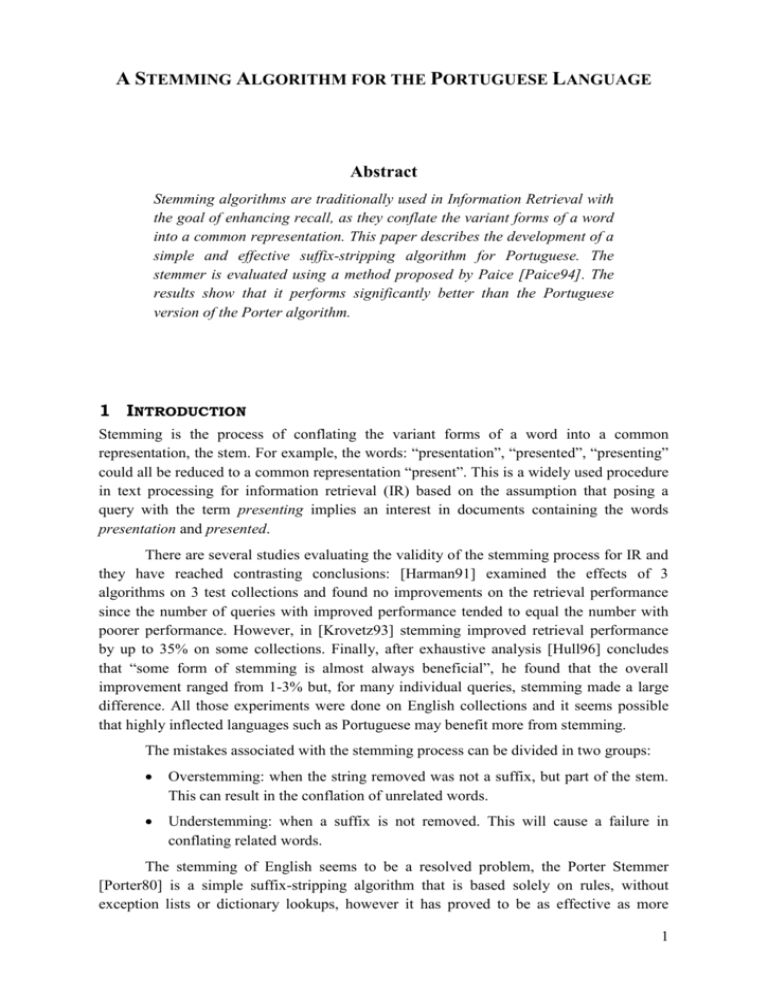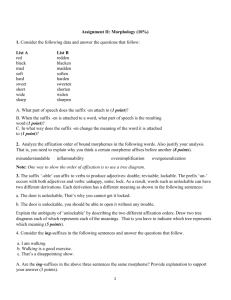3 Difficulties in Stemming Portuguese
advertisement

A STEMMING ALGORITHM FOR THE PORTUGUESE LANGUAGE
Abstract
Stemming algorithms are traditionally used in Information Retrieval with
the goal of enhancing recall, as they conflate the variant forms of a word
into a common representation. This paper describes the development of a
simple and effective suffix-stripping algorithm for Portuguese. The
stemmer is evaluated using a method proposed by Paice [Paice94]. The
results show that it performs significantly better than the Portuguese
version of the Porter algorithm.
1 INTRODUCTION
Stemming is the process of conflating the variant forms of a word into a common
representation, the stem. For example, the words: “presentation”, “presented”, “presenting”
could all be reduced to a common representation “present”. This is a widely used procedure
in text processing for information retrieval (IR) based on the assumption that posing a
query with the term presenting implies an interest in documents containing the words
presentation and presented.
There are several studies evaluating the validity of the stemming process for IR and
they have reached contrasting conclusions: [Harman91] examined the effects of 3
algorithms on 3 test collections and found no improvements on the retrieval performance
since the number of queries with improved performance tended to equal the number with
poorer performance. However, in [Krovetz93] stemming improved retrieval performance
by up to 35% on some collections. Finally, after exhaustive analysis [Hull96] concludes
that “some form of stemming is almost always beneficial”, he found that the overall
improvement ranged from 1-3% but, for many individual queries, stemming made a large
difference. All those experiments were done on English collections and it seems possible
that highly inflected languages such as Portuguese may benefit more from stemming.
The mistakes associated with the stemming process can be divided in two groups:
Overstemming: when the string removed was not a suffix, but part of the stem.
This can result in the conflation of unrelated words.
Understemming: when a suffix is not removed. This will cause a failure in
conflating related words.
The stemming of English seems to be a resolved problem, the Porter Stemmer
[Porter80] is a simple suffix-stripping algorithm that is based solely on rules, without
exception lists or dictionary lookups, however it has proved to be as effective as more
1
elaborated systems. Similar algorithms have been developed for other languages
[Honrado00, Kraaij94, Wechsler97]. Our challenge is to design a suffix-stripping algorithm
that is both simple and effective with the target of improving recall, without decreasing
precision. This paper describes the development of an effective stemmer for Portuguese.
The remainder of this paper is organised as follows: section 2 describes the
algorithm; section 3 comments on the biggest difficulties faced; section 4 shows the results
of the tests carried out on the stemmer and finally section 5 presents the final conclusions.
2 THE ALGORITHM
The algorithm was implemented in C and is composed by 8 steps that need to be executed
in a certain order. Figure 1 shows the sequence those steps must obey:
Begin
Word ends
in "s" ?
No
Yes
Plural
Reduction
Word ends
in "a" ?
No
Yes
Feminine
Reduction
Augmentative
Reduction
Adverb
Reduction
Noun
Reduction
Suffix
Removed
Yes
No
Verb
Reduction
Suffix
Removed
No
Remove
Vowel
Yes
Remove
Accents
End
Figure 1. Sequence of steps for the Portuguese Stemmer
Each step has a set of rules, the rules in the steps are examined in sequence and only
one rule in a step can apply. The longest possible suffix is always removed first because of
the order of the rules within a step, e.g. the plural suffix –es should be tested before the
suffix –s. At the moment, the Portuguese Stemmer contains 199 rules, please refer to the
Appendix for the complete list.
Each rule states:
The suffix to be removed;
The minimum length of the stem: this is to avoid removing a suffix when the
2
stem is too short. This measure varies for each suffix, and the values we set by
observing lists of words ending in the given suffix. Although there is no
linguistic support for this procedure it reduces overstemming errors.
A replacement suffix to be appended to the stem, if applicable;
A list of exceptions: for nearly all rules we defined, there were exceptions, so
we added exception lists for each rule. Such lists were constructed with the aid
of a vocabulary of 32,000 Portuguese words freely available at [Muscat]. Tests
with the stemmer have shown that exceptions list reduce overstemming mistakes
by 5%.
An example of a rule is:
"inho", 3, ””, {"caminho", "carinho", "cominho", "golfinho",
"padrinho", "sobrinho", "vizinho"}
Where “inho” is a suffix that denotes diminutive, 3 is the minimum size for the
stem, which prevents words like “linho” (linen) from being stemmed and the words
between brackets are the exceptions for this rule, that is, they end in the suffix but they are
not diminutives. All other words that end in –inho and that are longer than 6 characters will
be stemmed. There is no replacement suffix in this rule.
Note that the stems do not have to be linguistically meaningful, since they are used
to index a database of documents and are not presented to the user. They need however, to
capture the word meaning without losing too much detail.
Step 1: Plural Reduction
With rare exceptions, the plural forms in Portuguese end in –s. However, not all
words ending in –s denote plural, e.g. lápis, (pencil). This step consists basically in
removing the final “s” of the words that are not listed as exceptions. Yet sometimes a few
extra modifications are needed e.g. words ending in –ns should have that suffix replaced by
“m” like in bons bom.
Step 2: Feminine Reduction
All nouns and adjectives in Portuguese have a gender. This step consists in
transforming feminine forms to their corresponding masculine. Only words ending in –a
are tested in this step but not all of them are converted, just the ones ending in the most
common suffixes, e.g. chinesa chinês.
Step 3: Adverb Reduction
This is the shortest step of all, as there is just one suffix that denotes adverbs –
mente. Again not all words with that ending are adverbs so an exception list is needed.
Step 4: Augmentative/Diminutive Reduction
Portuguese nouns and adjectives present far more variant forms than their English
counterparts. Words have augmentative, diminutive and superlative forms e.g. “small
3
house” = casinha, where –inha is the suffix that indicates a diminutive. Those cases are
treated by this step. According to [Cunha85] there are 38 of these suffixes, however some
of them are obsolete therefore, in order to avoid overstemming, our algorithm uses only the
most common ones that are still in common usage.
Step 5: Noun Suffix Reduction
This step tests words against 61 noun (and adjective) endings. If a suffix is removed
here, steps 6 and 7 are not executed.
Step 6: Verb Suffix Reduction
Portuguese is a very rich language in terms of verbal forms, while the regular verbs
in English have just 4 variations (e.g. talk, talks, talked, talking), the Portuguese regular
verbs have over 50 different forms [Macambira99]. Each one has its specific suffix. The
verbs can vary according to tense, person, number and mode. The structure of the verbal
forms can be represented as: root + thematic vowel1 + tense + person, e.g. and + a + ra + m
(they walked). Verbal forms are reduced to their root.
Step 7: Vowel Removal
This task consists in removing the last vowel (“a”, “e” or “o”) of the words which
have not been stemmed by steps 5 and 6, e.g. the word menino (boy) would not suffer any
modifications by the previous steps, therefore this step will remove its final –o, so that it
can be conflated with other variant forms such as menina, meninice, meninão, menininho,
which will also be converted to the stem menin.
Step 8: Accents Removal
Removing accents is necessary because there are cases in which some variant forms of
the word are accented and some are not, like in psicólogo (psychologist) and psicologia
(psychology), after this step both forms would be conflated to psicolog. It is important that
this step is done at this point and not right at the beginning of the algorithm because the
presence of accents is significant for some rules e.g. óis ol transforming sóis (suns) to
sol (sun). If the rule was ois ol instead, it would make mistakes like stemming dois (two)
to dol.
3 DIFFICULTIES IN STEMMING PORTUGUESE
Stemming Portuguese is much more troublesome than stemming English due to its more
complex morphology. Below we discuss some particularly important difficulties:
1
Dealing with Exceptions: As mentioned before one of the biggest difficulties in
building this stemming algorithm was that for nearly every rule we formulated there are
exceptions, e.g. “ão” is a commonly used suffix to denote augmentative, however not
There are 3 classes of verbs in Portuguese according to the ending of their infinitive form: “ar”, “er”, “ir”.
Thematic Vowel the letter (“-a”, “-e” and “-i”) that groups verbs into categories.
4
all words ending in “ão” are in augmentative forms. Therefore, unlike the Porter
stemmer we had to use exceptions lists. If we had chosen not to use such lists, the
stemmer would make overstemming errors if we kept the rule or understemming errors
if we dropped it.
Homographs2: There are several such cases, many involving conjugated verbs, e.g.
casais which can mean “couples” or 2nd person plural of the verb “to marry”. Our
algorithm does not have information about word categories, so the different senses of
those words are not distinguished. For this specific case, the stemmer assumes the first
meaning and stems the word to its singular form casal, this is due to the 2nd person
plural being nearly obsolete in modern Portuguese.
Irregular verbs: The current version of the stemmer is not treating irregular verbs, but
surprisingly they do not seem to seriously affect our results. The tests have shown that
less than 1% of the mistakes occur because of this reason.
Changes to the morphological root: There are cases in which the inflection process
changes the root of the word. The cases in which the change obeys orthographic rules
(e.g. ns m) are being successfully treated. As for the other cases, we are still looking
for an effective way of dealing with them. At the moment, words like emitir (to emit)
and emissão (emission), which are semantically related, are not being conflated, as the
first is stemmed to emit and the later to emis.
Stemming proper names: Proper names should not be stemmed, the problem is
recognising them. A list of proper names does not present an ideal solution for two
main reasons: there are infinite possibilities and some proper names are shared by
names of things, e.g. Pereira is a common Portuguese surname but it also means “pear
tree”. As the Porter stemmer, the present implementation of our algorithm is stemming
proper names.
4 EVALUATING OUR STEMMER
In order to assess the effectiveness of our stemmer we carried out a sequence of tests. Those
tests used a vocabulary of 32,000 distinct word forms obtained from [Muscat]. We tested
our algorithm against the Portuguese version of the Porter stemmer [Muscat] applied to the
same vocabulary.
4.1 Vocabulary Reduction
One of the original purposes of suffix-stripping was reducing the size of the vocabulary for
indexing purposes. Porter reports a reduction of about a third of the vocabulary, using his
stemmer over 10,000 different English words. The Portuguese version of the Porter
stemmer reduces the vocabulary by 44 %; this is because Portuguese has far more variant
forms than English. Our stemmer reduces the vocabulary by 51%.
2
Homographs are words which are spelled identically but which have different meanings.
5
4.2 Comparison Against Expected Output
This was the method used to train our stemmer, we randomly selected 2800 words from our
vocabulary and manually assigned for each one its correct stem. We then tested the
calculated stems against the expected output and analysed the errors to check if new rules
or exceptions were needed. However, there is a stage on the designing of a stemming
algorithm in which the addition of new rules with the target of avoiding errors on a specific
case causes inaccuracies in other instances. At the end of the training process our stemmer
was achieving 98% precision on the training vocabulary.
We then decided to evaluate its performance using a set of words that had not been
used in the training, so we selected another 1000 words and again assigned for each one its
correct stem. Our algorithm calculated the right stem 96% of the times outperforming the
Portuguese version of the Porter stemmer which calculated the right stem 71% of the times,
for the same test set. We are aware that this was a very small test set and we intend to
repeat this experiment on a larger sample.
4.3 Paice’s Evaluation Method
The standard evaluation method of a stemming algorithm is to apply it to an IR test
collection and calculate recall and precision to assess how the algorithm affects those
measurements. However, this method does not show the specific causes of errors therefore
it does not help the designers to optimise their algorithms. [Paice94] proposes an evaluation
method in which stemming is assessed against predefined groups of semantically related
words. He introduced three new measurements: over and understemming index and the
stemming weight. This test requires a sample of different words partitioned into concept
groups containing forms that are morphologically and semantically related to one another.
The perfect stemmer should conflate all words in a group to the same stem and that stem
should not occur in any other group. Section 4.3.1 describes the method and section 4.3.2
shows the results achieved by our stemmer and the Portuguese version of Porter’s
algorithm.
4.3.1 Method Description
For each concept group two totals are computed:
Desired merge total (DMT), which is the number of different possible word form pairs
in the particular group, and is given by the formula:
DMTg = 0.5 ng (ng – 1)
where ng is the number of words in that group.
Desired Non-merge Total (DNT), which counts the possible word pairs formed by a
member and a non-member word and is given by the formula:
DNTg = 0.5 ng (W – 1)
where W is the total number of words. By summing the DMT for all groups we obtain the
GDMT (global desired merge total) and, similarly, by summing the DNT for all groups we
obtain the GDNT (global desired non-merge total). After applying the stemmer to the
6
sample, some groups still contain two or more distinct stems, incurring in understemming
errors. The Unachieved Merge Total(UMT) counts the number of understemming errors for
each group and is given by:
UMTg = 0.5 i=1..s ui (ng – ui)
where s is the number of distinct stems and ui is the number of instances of each stem. By
summing the UMT for each group we obtain the Global Unachieved Merge Total (GUMT).
The understemming index (UI) is given by: GUMT/GDMT.
After stemming, there can be cases where the same stem occurs in two or more different
groups, which means there are overstemming errors. By partitioning the sample into groups
that share the same stem we can calculate the Wrongly Merged Total (WMT), which counts
the number of overstemming errors for each group. The formula is given by:
WMTg = 0.5 i=1..t vi (ns – vi)
where t is the number of original groups that share the same stem, ns is the number of
instances of that stem and vi is the number of stems for each group t. By summing the
WMT for each group we obtain the Global Wrongly-Merged Total (GWMT). The
overstemming index (OI) is given by: GWMT/GDNT. The Stemming Weight (SW) is
given by the ratio OI/UI.
Here is one example, supposing we had the following sample divided into 5 concept
groups:
1. ajud (help): ajuda, ajudando, ajudinha, ajudei
2. duvid (doubt): duvido, dúvida, duvidamos, duvidem
3. chec (to check): checando, chequei, checamos, checou
4. beb (to drink): bebo, bebes, bebi, bebendo, bêbado, bebida
5. bebê (baby): bebê, bebezinho
Calculating GDMT, and GDNT, we have:
Group
1
2
3
4
5
Totals
DMT
6
6
6
15
1
34
DNT
32
32
32
37.5
9.5
143
After the stemming process we have:
1.
2.
3.
4.
5.
ajud, ajud, ajud, ajud
duvid, duvid, duvid, duvid
chec, chequ, chec, chec
beb, beb, beb, beb, beb, beb
beb, beb
We have two kinds of mistake in this case: the words in group 3 were not conflated to
the same stem (understemming), and words in groups 4 and 5 were stemmed to the same
form (overstemming). Calculating GUMT we have:
7
Group
1
2
3
4
5
GUMT
UMT
0
0
3
0
0
3
Now we reorganise the sample into groups that share the same stem, in order to
calculate GWMT:
1.
2.
3.
4.
5.
ajud(1), ajud(1), ajud(1), ajud(1)
duvid(2), duvid(2), duvid(2), duvid(2)
chec(3), chec(3), chec(3)
chequ(3)
beb(4), beb(4), beb(4), beb(4), beb(4), beb(4), beb(5), beb, (5)
Group
ajud
duv
chec
chequ
beb
GWMT
WMT
0
0
0
0
12
12
The Understemming Index (UI) given by GUMT/GDMT is 0.088 The
Overstemming Index (OI) given by GWMT/GDNT is 0.083. The Stemming Weight (SW)
given by OI/UI is 1.06. Paice’s method does not offer a framework to assess the values of
UI and OI, however it suggests that a one stemmer will be better than another in terms of
UI and worse in terms of OI.
4.3.2 Comparison between the Two Stemmers
In order to compare the performance of the two Portuguese stemmers we selected another
sample of 1000 words divided into 170 groups. The results obtained were:
For the Portuguese version of the Porter stemmer:
UI: 0.215
OI: 2.11 10-4
SW: 9.81 10-4
For our algorithm:
UI: 0.034
OI: 9.85 10-5
SW: 2.89 10-3
The results show that our stemmer makes less understemming errors and less overstemming
errors that the Portuguese version of Porter’s Algorithm, thus we can conclude that our
8
stemmer is more efficient. Again the test was done over a small sample of words and we
intend to repeat it over a larger test set.
5 CONCLUSION
This paper presented the development of a stemming algorithm for Portuguese. The
algorithm is simple yet highly effective, it is based on a set of steps composed by a
collection of rules. Each rule specifies the suffix to be removed; the minimum length
allowed for the stem; a replacement suffix, if necessary and a list of exceptions.
The stemmer was evaluated using 3 different methods, including the one proposed
by Paice [Paice94] and outperformed the Portuguese version of the Porter stemmer in all
tests. Future work will include using the Portuguese stemmer on an Information Retrieval
system to access its impact over recall and precision.
REFERENCES
[Cunha85] CUNHA, C. and Lindley-Cintra, L. Nova Gramática do Português Contemporâneo.
ed. Nova Fronteira, Rio de Janeiro, 1985, 719 p.
[Frakes92] Frakes,W.B. Stemming Algorithms. In Frakes,W.B. and Baeza-Yates,R. (editors)
Information Retrieval – Data Structures and Algorithms. Prentice Hall, London, 1992,
p. 131-160.
[Harman91] Harman, D. How effective is suffixing? In: Journal of the American Society for
Information Science 42(1), 1991, p. 7-15.
[Honrado00] Honrado, A. et al. A Word Stemming Algorithms for the Spanish Language. In:
Proceedings of the String Processing and Information Retrieval Conference (SPIRE),
A Coruña, Spain, Sept. 27-29, 2000.
[Hull96] Hull, D.A. Stemming Algorithms: A Case Study for Detailed Evaluation. In: Journal of
the American Society for Information Science 47(1), 1996, p. 70-84.
[Kraaij94] Kraaij, W. and Pohlmann, R. Porter’s Stemming Algorithm for Dutch. In L.G.M.
Noordman and W.A.M. de Vroomen, editors, Informatiewetenschap 1994:
Wetenschappelijke bijdragen aan de derde STINFON Conferentie, pp. 167-180, Tilburg,
1994. http://www-uilots.let.uu.nl/uplift/stinfon.ps
[Krovetz93] Krovetz, R. Viewing morphology as an inference process. In: ACM SIGIR
Conference on Research and Development in Information Retrieval, 1993, pp. 191202.
[Macambira99] Macambira, J.R. A Estrututa Morfo-Sintática do Português. Ed. Pioneira, São
Paulo, 1999.
[Muscat] http://open.muscat.com
9
[Paice94] Paice, C.D. An Evaluation Method for Stemming Algorithms. In: ACM SIGIR
Conference on Research and Development in Information Retrieval, 1994, pp. 42-50.
[Porter80] Porter, M.F. An Algorithm for Suffix Stripping. Program, 14(3), 130-137.
[Wechsler97] Wechsler, M.; Sheridan, P.; Schäuble, P. Multi-Language Text Indexing for
Internet Retrieval. Proceedings of the 5th RIAO Conference Computer Assisted
Information Searching on the Internet. Montreal-Canada, June, 1997.
10
APPENDIX – SUFFIX STRIPPING RULES
Those are the rules for stemming Portuguese. The exceptions list is omitted due to limited
space.
Plural Reduction Rules
Suffix to Remove
"ns"
"ões"
"ães"
"ais"
"éis"
"eis"
"óis"
"is"
"les"
"res"
"s"
Minimum Stem Size
1
3
1
1
2
2
2
2
3
3
2
Replacement
"m"
"ão"
"ão"
"al"
"el"
"el"
"ol"
"il"
"l"
"r"
Example
bons bom
balões balão
capitães capitão
normais normal
papéis papel
amáveis amável
lençóis lençol
barris barril
males mal
mares mar
casas casa
Replacement
"ão”
"ão”
"or"
"no”
"inho"
"ês"
"oso"
"íaco"
"ico"
"ado"
"ido"
"ido"
"imo"
"ivo"
"eiro"
Example
chefona chefão
vilã vilão
professora professor
americana americano
chilena chileno
sozinho sozinha
inglesa inglês
famosa famoso
maníaca maníaco
prática prático
mantida mantido
cansada cansado
prima primo
passiva passivo
primeira primeiro
Replacement
Example
felizmente feliz
Feminine Reduction Rules
Suffix to Remove
"ona"
“ã”
"ora"
"na"
"inha"
"esa"
"osa"
"íaca"
"ica"
"ada"
"ida"
"ída"
"ima"
"iva"
"eira"
Minimum Stem Size
3
2
3
4
3
3
3
3
3
2
3
3
3
3
3
Adverb Reduction Rule
Suffix to Remove
"mente"
Minimum Stem Size
4
Augmentative/Dimunutive Reduction Rules
Suffix to Remove
"díssimo"
"abilíssimo"
"íssimo"
"ésimo"
"érrimo"
"zinho"
"quinho"
"uinho"
"adinho"
"inho"
"alhão"
Minimum Stem Size
5
5
3
3
4
2
4
4
3
3
4
Replacement
"c"
Example
cansadíssimo cansad
amabilíssimo ama
fortíssimo fort
chiquérrimo chiqu
pezinho pe
maluquinho maluc
amiguinho amig
cansadinho cansad
carrinho carr
grandalhão grand
11
"uça"
"aço"
"adão"
"ázio"
"arraz"
"arra"
"zão"
"ão"
dentuça dent
ricaço ric
casadão cans
corpázio corp
pratarraz prat
bocarra boc
calorzão calor
meninão menin
4
4
4
3
4
3
2
3
Noun Reduction Rules
Suffix to
Remove
"encialista"
"alista"
"agem"
"iamento"
"amento"
"imento"
"alizado"
"atizado"
"izado"
"ativo"
"tivo"
"ivo"
"ado"
"ido"
"ador"
"edor"
"idor"
"atória"
"or"
"abilidade”
"icionista"
"cionista"
"ional"
"ência"
"ância"
"edouro"
"queiro"
"eiro"
"oso"
"alizaç"
"ismo"
Min
Size
4
5
3
4
3
3
4
4
5
4
4
4
2
3
3
3
4
5
2
5
4
5
4
3
4
3
3
3
3
5
3
Repl Example
"c"
existencialista exist
minimalista minim
contagem cont
genrenciamento gerenc
monitoramento monit
nascimento nasc
comercializadocomerci
traumatizado traum
alfabetizadoalfabet
associativo associ
contraceptivocontracep
esportivoesport
abalado abal
impedido imped
ralador ral
entendedorentend
cumpridorcumpr
obrigatóriaobrig
produtorprodut
comparabilidadecompar
abolicionistaabol
intervencionistainterven
profissionalprofiss
referênciarefer
repugnânciarepugn
abatedouroabat
fofoqueirofofoc
brasileirobrasil
gostosogost
comercializaçcomerci
consumismoconsum
Suffix to
Remove
"izaç"
"aç"
"iç"
"ário"
"ério"
"ês"
"eza"
"ez"
"esco"
"ante"
"ástico"
"ático"
"ico"
"ividade"
"idade"
"oria"
"encial"
"ista"
"quice"
"ice"
"íaco"
"ente"
"inal"
"ano"
"ável"
"ível"
"ura"
"ual"
"ial"
"al"
Min
Size
5
3
3
3
6
4
3
4
4
2
4
3
4
5
5
4
5
4
4
4
3
4
3
4
2
5
4
3
3
4
Repl Example
"c"
concretizaçconcret
alegaçaleg
aboliçabol
anedotárioanedot
ministériominist
chinês chin
beleza bel
rigidezrigid
parentescoparent
ocupanteocup
bombásticobomb
problemáticoproblem
polêmicopolêm
produtividadeprodut
profundidadeprofund
aposentadoriaaposentad
existencialexist
artistaart
maluquicemaluc
chatice chat
demoníacodemon
decorrentedecorr
criminalcrim
americano americ
amável am
combustívelcombust
coberturacobert
consensualconsens
mundialmund
experimentalexperiment
12
Verb Reduction Rules
Suffix to
Remove
"aríamo"
"ássemo"
"eríamo"
"êssemo"
"iríamo"
"íssemo"
"áramo"
"árei"
"aremo"
"ariam"
"aríei"
"ássei"
"assem"
"ávamo"
"êramo"
"eremo"
"eriam"
"eríei"
"êssei"
"essem"
"íramo"
"iremo"
"iriam"
"iríei"
"íssei"
"issem"
"ando"
"endo"
"indo"
"ondo"
"aram"
"arde"
"arei"
"arem"
"aria"
"armo"
"asse"
"aste"
"avam"
"ávei"
"eram"
"erde"
"erei"
"êrei"
"erem"
Min
Size
2
2
2
2
3
3
2
2
2
2
2
2
2
2
3
3
3
3
3
3
3
3
3
3
3
3
2
3
3
3
2
2
2
2
2
2
2
2
2
2
3
3
3
3
3
Repl Example
cantaríamo cant
cantássemo cant
beberíamo beb
bebêssemo beb
partiríamo part
partíssemo part
cantáramo cant
cantárei cant
cantaremo cant
cantariam cant
cantaríei cant
cantássei cant
cantassem cant
cantávamo cant
bebêramo beb
beberemo beb
beberiam beb
beberíei beb
bebêssei beb
bebessem beb
partiríamo part
partiremo part
partiriam part
partiríei part
partíssei part
partissem part
cantando cant
bebendo beb
partindo part
propondo prop
cantaram cant
cantarde cant
cantarei cant
cantarem cant
cantaria cant
cantarmo cant
cantasse cant
cantaste cant
cantavam cant
cantávei cant
beberam beb
beberde beb
beberei beb
bebêrei beb
beberem beb
Suffix to
Remove
"eria"
"ermo"
"esse"
"este"
"íamo"
"iram"
"íram"
"irde"
"irei"
"irem"
"iria"
"irmo"
"isse"
"iste"
"amo"
"ara"
"ará"
"are"
"ava"
"emo"
"era"
"erá"
"ere"
"iam"
"íei"
"imo"
"ira"
"irá"
"ire"
"omo"
"ai"
"am"
"ear"
"ar"
"uei"
"ei"
"em"
"er"
"eu"
"ia"
"ir"
"iu"
"ou",
"i"
Min
Size
3
3
3
3
3
3
3
2
3
3
3
3
3
4
2
2
2
2
2
2
3
3
3
3
3
3
3
3
3
3
2
2
4
2
3
3
2
2
3
3
3
3
3
3
Repl Example
beberia beb
bebermo beb
bebesse beb
bebeste beb
bebíamo beb
partiram part
concluíram conclu
partirde part
partírei part
partirem part
partiria part
partirmo part
partisse part
partiste part
cantamo cant
cantara cant
cantará cant
cantare cant
cantava cant
cantemo cant
bebera beb
beberá beb
bebere beb
bebiam beb
bebíei beb
partimo part
partira part
partirá part
partire part
compomo comp
cantai cant
cantam cant
barbearbarb
cantar cant
cheguei cheg
cantei cant
cantem cant
beber beb
bebeu beb
bebia beb
partir part
partiu part
chegou cheg
Bebi beb
Vowel Removal Rules
Suffix to Remove
"a"
“e”
"o"
Minimum Stem Size
3
3
3
Replacement
Example
menina menin
grande grand
menino menin
13







